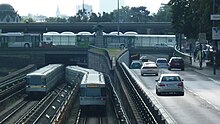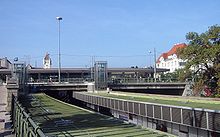Kennedy Bridge (Vienna)
The Kennedy Bridge is a bridge over the Wien River and connects the two districts of Penzing and Hietzing in Vienna . It is combined with the Hietzing underground station and is a hub for tram and bus lines. The building, previously known as Hietzinger Bridge , was named after him at the end of 1963, one month after the President of the United States , John F. Kennedy , was assassinated .
history

At the site of today's Kennedy Bridge there was once a ford that was part of a Roman road to the then legionary camp Vindobona . From 1819 there was a wooden footbridge next to the ford.
Maria Anna Bridge
1834-1843 a chain bridge was built after Empress Maria Anna , wife of Emperor I. Ferdinand , Maria-Anna Bridge was called. The bridge was designed by Josef Jäckel and completed by the Neubauer surrogate coffee maker Johann Gemperle. In 1888 this bridge was removed.
Kaiser-Franz-Joseph-Bridge
1888–1890 a new iron truss bridge was built in its place, which was named after the ruling monarch in view of the nearby imperial summer residence, Schönbrunn Palace . The details of the planned regulation of the Vienna river and the construction of the city railroad were apparently not yet known; in any case, the bridge had to be dismantled in 1898 after only eight years of operation because it was in the way of this work.
2. Kaiser-Franz-Joseph Bridge, Hietzinger Bridge
In 1898, the year the upper Wiental line of the Stadtbahn was opened, which received a station called Hietzing next to the bridge, construction of the second Kaiser-Franz-Joseph Bridge began, based on a design by Friedrich Ohmann and Josef Hackhofer . Its construction was completed in 1900. The Vienna River was regulated in the urban area from 1895–1903. Compared to most of the other Vienna river bridges built around this time, this one was designed in a particularly artistic way. The front sides were adorned with ornaments, on two pylons sat bronze sculptures created by Arthur Strasser in the form of eagles carrying the imperial crown on their backs. The bridge was now also passable for the tram . While the horse-drawn tram, coming from the Mariahilfer Gürtel , had already been running since 1869 through Hadikgasse to Nisselgasse in Penzing, the northern access to the bridge, from 1899 it could drive over the bridge into Hietzinger Hauptstrasse (to Dommayergasse); In 1901 the line was electrified.
In 1912/1913 the office building for the 13th and 14th district was built next to the bridge (until 1938 only for the 13th district). In 1913 the bridge was rebuilt. In 1921 it was renamed Hietzinger Bridge . In 1936 the underpass for private traffic on the Hietzinger Kai was completed. The rapid increase in traffic on the bridge after the Second World War made it necessary to build a new building again.
New bridge construction 1961–1964
From 1961 - with special consideration of the traffic situation at this point including the tram station to be integrated , which had previously been located next to the bridge - a reinforced concrete bridge was built. Its architectural distinguishing feature is the striking suspended roof that runs around the central bridge area, under which the reception building of the underground station and waiting areas for the tram stops are located. The tram's turning loop, which can be driven clockwise, runs around the canopy , outside of it there is an (incomplete) counter-clockwise roundabout for buses and private vehicles.
The new Hietzinger Bridge was completed in the summer of 1964 and named in December 1963 after the US President John F. Kennedy , who had been murdered a month earlier and who had met the Soviet Prime Minister Khrushchev in Vienna in 1961 . Otto Wagner's historic Stadtbahn station building , which was located upstream of the Hietzinger Bridge, was demolished in the course of this construction work.
present
In the center of the approximately 90-meter-wide bridge there is the reception building for the Hietzing station (light rail, underground line U4 since 1981 ), three tram stops and a bus stop for buses traveling in the direction of Hietzing. On the outside there are directional lanes for car traffic and sidewalks. A cycle path (Wiental route) laid out decades later crosses all other connections. The two listed bronze eagles from the previous structure are still to be found on the pylons on the upstream side of the Kennedy Bridge. The imperial court pavilion , which was originally intended as a separate light rail reception building for the emperor and his entourage and is now a branch of the Wien Museum, is just 150 meters downstream .
The Kennedy bridge / Hietzing U station is (from here south to the new terminus September 2, 2017 the tram lines 10 sub-St.-Veit , Hummelgasse extended) and 60 (from here north to the new terminal since September 2, 2017 Westbahnhof extended ) served; line 58, which had been running here since 1907, was discontinued. Furthermore, the urban bus lines 56A, 56B, 58A and 58B have their northern terminus on the bridge. The bus line 51A, which runs north, turns immediately north of the bridge on Nisselgasse. The changes from September 2017 were made in order to find space on the bridge for the unbundling of traffic flows.
Immediately next to the Kennedy Bridge are numerous local supply shops in both the 13th and 14th district; The Parkhotel Schönbrunn, completed in 1908, is located in the 13th district . Also nearby is the Hietzinger Tor to Schönbrunn Palace Park and the Ekazent Hietzing, which opened in 1964 and was designed by Wolfgang and Traude Windbrechtinger .
District boundary
The border between the 13th district on the southern, right bank of the Wien River and the 14th district on the northern, left bank has existed since 1938 and crosses the bridge north of the subway station entrances. It runs along the right, south-facing quay wall of the Wien River. Thus, the underground line with the station is in the 13th district, the river itself in the 14th district.
literature
- Alfred Pauser: Bridges in Vienna - A guide through the history of construction . Springer Verlag, Vienna 2005, ISBN 3-211-25255-X .
Web links
Individual evidence
- ^ Felix Czeike : Historical Lexicon Vienna. Volume 3: Ha-La. Kremayr & Scheriau, Vienna 1994, ISBN 3-218-00545-0 , p. 183.
- ↑ A figural ornament of the Hietzinger Bridge. In: Illustrirtes Wiener Extrablatt , January 17, 1903, p. 5 (online at ANNO ).
- ↑ Michael Matzenberger: Wiener Linien discontinues tram line 58. derStandard.at, April 13, 2017, accessed on May 6, 2017 .
Coordinates: 48 ° 11 ′ 16.2 ″ N , 16 ° 18 ′ 15.2 ″ E




